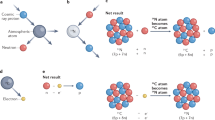Abstract
Fission track analysis has been used to determine the age and uranium content of obsidians from sources in southeast Europe and Anatolia, and from archaeological deposits in mesolithic levels at the Franchthi Cave in southern Greece. It is confirmed that the Franchthi obsidian came from the Aegean island of Melos. This is the earliest positive indication available for maritime travel, and carries the history of seafaring back a thousand years.
This is a preview of subscription content, access via your institution
Access options
Subscribe to this journal
Receive 51 print issues and online access
$199.00 per year
only $3.90 per issue
Buy this article
- Purchase on Springer Link
- Instant access to full article PDF
Prices may be subject to local taxes which are calculated during checkout
Similar content being viewed by others
References
Cann, J. R., Dixon, J. E., and Renfrew, C., in Science in Archaeology (edit. by Brothwell, D., and Higgs, E. S.), 578 (Thames and Hudson, second ed., 1969).
Renfrew, C., Cann, J. R., and Dixon, J. E., Ann. Brit. School Archaeol. Athens, 60, 225 (1965).
Shackleton, N., and Renfrew, C., Nature 228, 1062 (1970).
Fleischer, R. L., Price, P. B., Walker, R. M., and Leakey, L. S. B., Nature, 205, 1138 (1965).
Cann, J. R., and Renfrew, C., Proc. Prehist. Soc. 30, 111 (1964).
Renfrew, C., Dixon, J. E., and Cann, J. R., Proc. Prehist. Soc. 32, 30 (1966).
Jacobsen, T. W., Hesperia, 38, 343 (1969).
Watanabe, N., and Suzuki, M., Nature, 222, 1057 (1969).
Kaneoka, I., and Suzuki, M., J. Geol. Soc. Japan, 76, 309 (1970).
Fleischer, R. L., and Price, P. B., Geochim. Cosmochim. Acta, 28, 755 (1964).
Suzuki, M., J. Anthropol. Soc. Nippon, 78 (1), 50 (1970).
Hair, M. W., Kaufhold, J., Maurette, M., and Walker, R. M., Radiat. Effects, 7, 285 (1971).
Durrani, S. A., and Hancock, D. A., Earth Planet. Sci. Lett., 8, 157 (1970).
Durrani, S. A., and Khan, H. A., Nature, 232, 320 (1971); Nature Physical Science, 232, 175 (1971).
Durrani, S. A., and Khan, H. A., Earth Planet. Sci. Lett., 9, 431 (1970).
Storzer, D., and Wagner, G. A., Earth Planet. Sci. Lett., 5, 463 (1969).
Theochares, D. R., I Avgi tis Thessalikis Proistorias, 79 (Philarchaios Etaireia, Volos, 1967).
Renfrew, C., Dixon, J. E., and Cann, J. R., Proc. Prehist. Soc., 34, 325 (1968).
Author information
Authors and Affiliations
Rights and permissions
About this article
Cite this article
DURRANI, S., KHAN, H., TAJ, M. et al. Obsidian Source Identification by Fission Track Analysis. Nature 233, 242–245 (1971). https://doi.org/10.1038/233242a0
Received:
Revised:
Issue Date:
DOI: https://doi.org/10.1038/233242a0
This article is cited by
-
Pleistocene Water Crossings and Adaptive Flexibility Within the Homo Genus
Journal of Archaeological Research (2021)
-
Electrofission and photofission as tools to measure actinides in environmental and biological samples
Journal of Radioanalytical and Nuclear Chemistry Articles (1992)
-
Provenance studies of obsidian artifacts: Trace elements analysis and data reduction
Journal of Radioanalytical and Nuclear Chemistry Articles (1986)
-
Fission Track Dating of the Obsidian of Lipari Island (Italy)
Nature (1973)
-
Neutron Activation Analysis of Aegean Obsidians
Nature (1972)
Comments
By submitting a comment you agree to abide by our Terms and Community Guidelines. If you find something abusive or that does not comply with our terms or guidelines please flag it as inappropriate.



